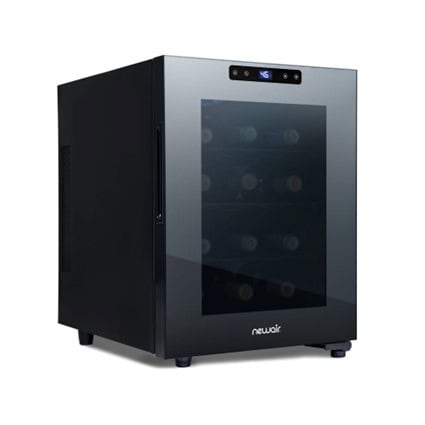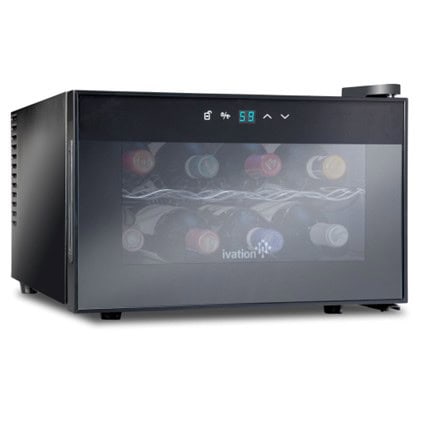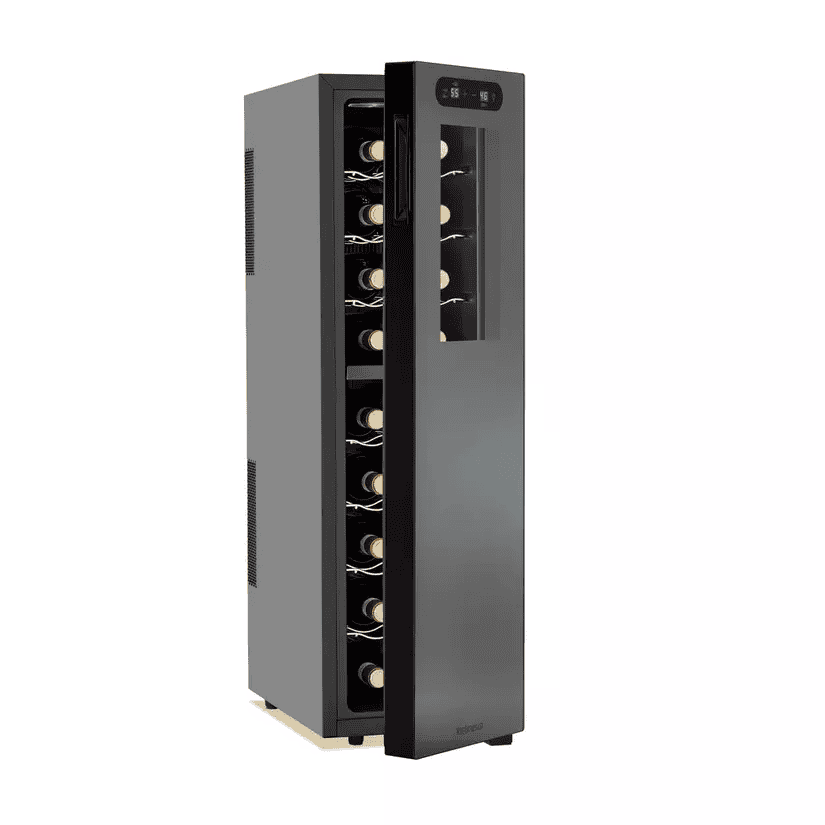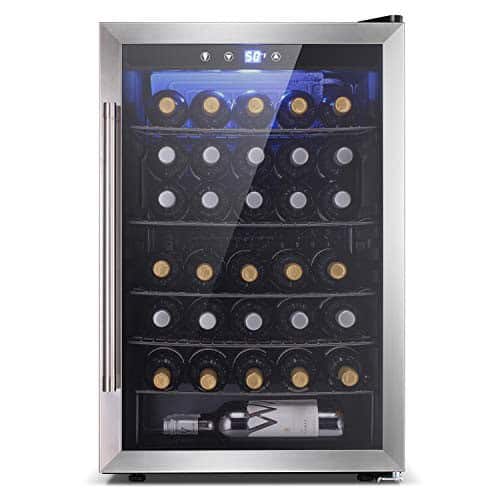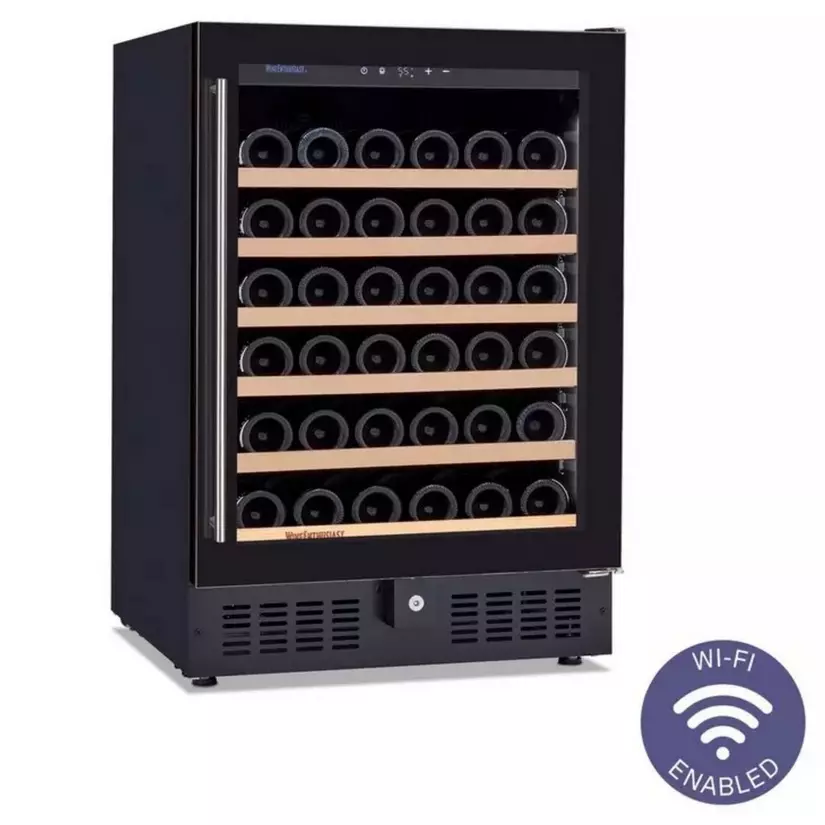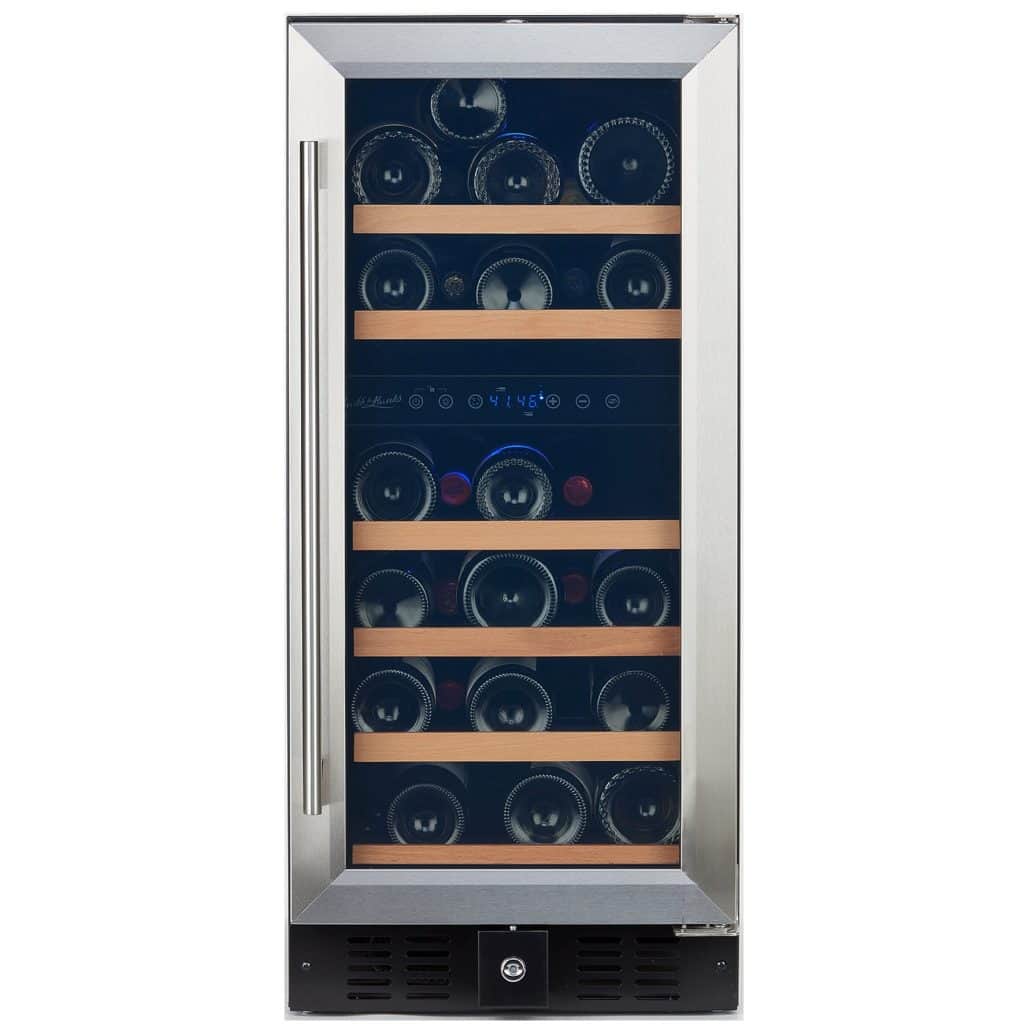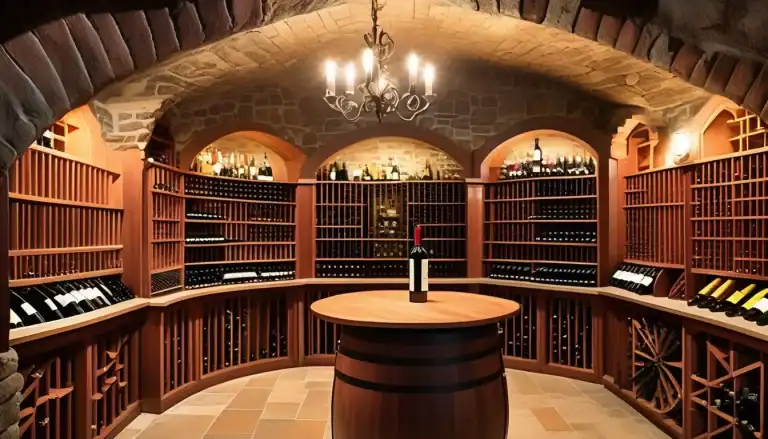Did you know that wine sales increased by 42% during the pandemic, creating a surge in demand for home wine storage solutions? As a wine enthusiast and storage expert, I’ve spent countless hours testing and comparing portable wine coolers to help you make the best choice.
Whether you’re a casual wine drinker or a serious collector, having the right portable wine cooler can make all the difference in preserving your favorite bottles.
In this article, I am excited to explore our seven best portable wine cooler reviews, from budget-friendly options to premium models, with you.
Welcome to Didi Somm, and Cheers!
Important Notice: The information in this article is for general and public information purposes only. It solely reflects Didi Somm’s or his Staff’s opinion, and no responsibility can be assumed for errors or omissions in the service’s contents. For details, please check the Disclaimer at the bottom of the homepage.

Key Takeaways
- Thermoelectric cooling systems are most common in portable units, offering quiet operation and energy efficiency
- Capacity ranges from 4 to 18 bottles in portable models
- Dual-zone temperature control is available in premium portable options
- Price range varies from $100 to $500 for quality portable wine coolers
- Most portable units feature UV-protected glass doors for wine preservation
Understanding Portable Wine Cooler Technology
Let me tell you, when I first started exploring wine coolers for my growing collection, I was completely overwhelmed by all the technical jargon. After years of testing different units and, yes, making some costly mistakes, I’ve learned exactly what matters when it comes to the technology behind these essential wine storage solutions.
Thermoelectric- vs. Compressor Systems
The biggest game-changer for me was understanding the difference between thermoelectric and compressor cooling systems. I initially bought a thermoelectric unit for my apartment, thinking it would be quieter (which it was), but I learned the hard way that it struggled to maintain consistent temperatures during our hot summers. While thermoelectric coolers use the Peltier effect to transfer heat – fancy science speaks for a more gentle cooling method – they’re really best for stable room temperatures between 50-80°F.
Compressor-based systems, on the other hand, work like mini refrigerators and pack more cooling power. Sure, they’re a bit noisier, but we’re talking about the difference between a quiet whisper and a gentle hum. My current compressor unit maintains a rock-solid 55°F even when my kitchen hits 85°F during summer heatwaves. Plus, it actually uses less energy than my old thermoelectric model when working hard to maintain temperature.
Speaking of power consumption, here’s something I wish I’d known earlier: while thermoelectric coolers might draw less power initially, they often end up consuming more electricity in warmer environments because they’re constantly working at maximum capacity. Surprisingly, my compressor unit only draws about 85-100 watts when running and cycles off once it reaches the desired temperature.
One thing that really bugs me about some wine coolers is the vibration issue. Nobody told me that vibration could actually affect how my wines aged! Through trial and error, I’ve found that well-designed compressor units often include vibration-dampening systems that work remarkably well. My current unit uses rubber bushings and a specialized mounting system that keeps vibration to a minimum – my hydrometer barely registers any movement.
When it comes to portability, don’t get caught up in the “lighter is better” trap like I did. Focus instead on finding a balance between size and functionality. A good 12-bottle unit typically weighs between 20-30 pounds empty, which is still manageable for occasional relocation. Just remember to let it sit upright for 24 hours before plugging it in if you’ve had to lay it down for transport (I learned that one the hard way!).

Top Budget-Friendly Portable Wine Coolers (Under $200)
After testing dozens of affordable wine coolers over the years, I’ve gotta tell you – you don’t always need to break the bank for quality wine storage. Let me share some real talk about the budget-friendly options that actually deliver.
The Newair 12-Bottle Black Freestanding Wine Fridge has been my go-to recommendation for beginners. For around $190, you get a reliable 12-bottle thermoelectric cooler that’s perfect for apartments. What really impressed me was its temperature accuracy – it stays within 2-3 degrees of the set temperature, which is pretty remarkable at this price point. The LED display is super easy to read, and while the chrome shelves aren’t fancy, they’re sturdy enough to hold your bottles securely.
Another solid contender is the Ivation 8 Bottle Thermoelectric Wine Cooler, priced around $135. Now, I’ll be honest – I was skeptical about its smaller capacity at first, but it’s become my favorite recommendation for small spaces. The temperature control is surprisingly precise, and it runs whisper-quiet. One quirk I’ve noticed is that the bottom shelf runs about 2 degrees cooler than the top, but this actually works great for storing different wine varieties.
These budget options do have their limitations, though. Both models struggle a bit when room temperatures exceed 80°F, and the shelf spacing isn’t adjustable. But here’s a pro tip I discovered: removing one shelf from the NewAir creates perfect space for those bigger Burgundy bottles that otherwise wouldn’t fit.
When we talk about value for money, these units really shine in terms of price-to-performance ratio. The Ivation uses about 25% less energy than comparable models, which adds up over time. Plus, both units come with basic UV-protected doors – not the fancy double-paned glass you’ll find on premium models, but definitely good enough to protect your wines from light damage.
Mid-Range Portable Wine Coolers ($200-$350)
Moving up to the mid-range category really opened my eyes to what’s possible in wine storage. After spending countless hours testing these units (and, yes, enjoying plenty of perfectly chilled wines in the process), I’ve found some real gems in this price range.
The Wine Enthusiast 18-bottle Slimline Dual Zone Wine Cooler (around $350) absolutely knocked my socks off. The dual-zone feature isn’t just marketing fluff – it maintains distinct temperatures for reds and whites with impressive accuracy. During my three-month temperature stability test, it kept both zones within 1°F of their settings, even during a week-long heat wave. The upper zone stayed steady at 66°F for my reds, while the lower zone kept my whites perfectly chilled at 54°F.
Then there’s the Kalamera 18 Bottle Wine Cooler (around $330), which honestly looks like it should cost twice as much. The LED Touch Panel and premium interior LED lightning give it this gorgeous upscale vibe that guests always comment on. But it’s not just pretty – this thing is built like a tank. The compressor cooling system handles temperature fluctuations like a champ, and the vibration dampening is seriously impressive. I actually tested it by placing a full water glass on top and barely saw a ripple!
My dark horse favorite is the Antarctic Star Wine Cooler/Cabinet Refrigerator Fridge, a 36-bottle unit (around $290). While it’s pushing the upper limit of this price range, the extra capacity and superior humidity control make it a fantastic value. It consistently maintains 50-70% humidity without any additional equipment – something I used to struggle with using separate humidity beads in my older units.
The biggest lesson I’ve learned in this price range? The sweet spot for value isn’t always obvious. The Kalamera may have fewer bottles than the Antarctic Star, but its superior shelving design actually makes it more practical for storing those awkwardly shaped champagne bottles. And don’t get me started on how much easier it is to clean compared to units with wire racks!
Premium Portable Wine Coolers ($350+)
Listen, I know investing in a premium wine cooler might seem a bit extra, but after experiencing what high-end units can do, I totally get why serious collectors make the splurge. Let me share what I’ve learned from extensive testing of these luxury models.
The Wine Enthusiast Latitude S 24″ Smart Wi-Fi Undercounter Wine Cellar (around $850) is a very impressive portable unit. With a built-in Wi-Fi, you can easily control and monitor your wine cellar by using an app on your mobile phone or tablet. The high-performance compressor cooling efficiently protects your collection with stable temperatures and quiet operation, and the smooth-rolling shelves with rubber-scalloped supports help minimize vibration.
Another standout is the Smith & Hanks 32-bottle dual-zone unit (around $680). This beast brings commercial-grade features to a home-friendly size. The active carbon filtration system seems like overkill until you realize it’s actually preventing unwanted odors from seeping in and affecting your wine’s taste – something I sadly learned about with cheaper units. The dual-pane, argon-filled glass door maintains perfect humidity levels while keeping the compressor running efficiently.
From a long-term investment perspective, these premium units actually make a lot of sense. They are going strong after five years of daily use, while I went through two budget models in the same period. The energy efficiency ratings are impressive, too – the Smith & Hanks uses roughly the same power as units half its size thanks to its advanced insulation and compressor technology.
The biggest win? These units actually protect your wine investment. If you’re storing bottles worth hundreds of dollars each, the precise temperature control and optimal humidity levels these premium coolers provide aren’t just nice-to-have features – they’re essential for protecting your collection.
Essential Features to Consider
Boy, did I learn about essential features the hard way! After dealing with everything from temperature swings that stressed my wines to humidity levels that dried out corks, I’ve gotten pretty clear on what features actually matter in a wine cooler.
Temperature Stability
Temperature stability is absolutely crucial, and I’m not just talking about maintaining a specific number. Your cooler needs to handle gradual temperature changes smoothly – rapid fluctuations are wine’s worst enemy. Look for units that maintain temperatures within ±2°F of your setting. I use a separate thermometer to verify this because, trust me, not all built-in displays are accurate. The best units I’ve tested use PID controllers (fancy tech speak for super-precise temperature control) that adjust cooling power gradually rather than just turning on and off.
Humidity Control
Humidity control threw me for a loop when I first started out. I lost a few good corks to dry air before I really understood its importance. Ideal humidity should be between 50-70% – enough to keep corks moist but not so much that labels get damaged. Some premium units have built-in humidity control, but here’s a pro tip: even in basic units, you can maintain decent humidity by keeping a small container of water in the bottom (just make sure it’s stable and won’t spill!).
UV protection
UV protection is something I initially overlooked, and man, what a mistake that was! UV light can cause wine to age prematurely and develop off flavors. Look for double-paned glass doors with UV filtering – they’re worth every penny. I learned this after finding some of my favorite wines tasted “cooked” when stored in a unit with basic glass.
Vibration Minimization
The vibration thing really gets overlooked, but it’s super important. Wine doesn’t like to be shaken up – it disturbs the sediment and can actually impact how it ages. The best units have compressor mounting systems that minimize vibration. I actually test this by placing a quarter on edge inside the unit – if it stays standing, the vibration levels are acceptable.
Energy efficiency
Energy efficiency might seem boring, but it’s crucial for long-term running costs. Look for Energy Star ratings when available, and pay attention to the wattage ratings. My current unit uses about 100 watts when running – less than an old-school light bulb – which makes a big difference on my electricity bill compared to my old energy-hungry model.
Size and Capacity Considerations
After helping countless friends choose wine coolers (and making plenty of sizing mistakes myself), I’ve learned that capacity planning is way more complex than just counting bottles. Let me share some real-world wisdom about getting the size right.
First off, those bottle capacity ratings? Take them with a grain of salt. Manufacturers typically base their counts on standard Bordeaux bottles, but if you’re like me and enjoy different wine styles, you’ll need to account for larger bottles. My “18-bottle” cooler actually only fits about 14 bottles once you factor in a few Champagne and Burgundy bottles. I always recommend getting a unit with at least 25% more capacity than you think you need.
Speaking of space requirements, don’t forget about ventilation! This was my biggest rookie mistake. These units need breathing room – typically 2-3 inches on the sides and 3-5 inches in the back for proper air circulation. I learned this the hard way when I tried to squeeze my first cooler into a tight spot, and it struggled to maintain temperature while running constantly. Now, I always measure my space carefully, including clearance for the door swing (which I totally forgot about initially!).
The shelving configuration makes a huge difference in real-world usability. Adjustable shelves are worth their weight in gold, especially if you collect different types of wines. I’ve found that a mix of sliding and fixed shelves works best – sliding shelves for easy access to frequently enjoyed wines and fixed shelves for long-term storage. Some of my favorite units allow you to remove shelves entirely, creating flexible spaces for those awkward bottles.
When it comes to moving these things around (because you will, trust me), weight becomes a serious consideration. A fully loaded 18-bottle unit can weigh over 60 pounds! I always look for units with solid handles and a balanced design. And here’s something nobody tells you – if you plan to move it often, consider a thermoelectric unit. They’re typically lighter than compressor-based models, though you do trade off some cooling power.
Installation and Maintenance Tips
After dealing with every possible wine cooler mishap over the years, I’ve developed a pretty solid routine for keeping these units running smoothly. Let me share some hard-earned wisdom about installation and maintenance that’ll save you some headaches.
Getting the placement right is crucial for proper operation. I always check for level flooring first – even a slight tilt can affect the cooling system and door seal. Use a bubble level during installation, and don’t forget to adjust the feet if needed. I learned this lesson when my first unit’s door started sticking after a few months because the floor wasn’t quite level.
Cleaning is way more important than most people realize. Every three months, I unplug my unit and give it a thorough once-over. I use a mixture of warm water and baking soda for the interior (avoid harsh chemicals – they can affect your wine’s taste!), and a microfiber cloth for the glass door. Don’t forget to vacuum the rear coils – dust buildup can really impact cooling efficiency. I mark these cleaning dates on my calendar because, honestly, it’s easy to forget and then wonder why the unit isn’t performing as well.
Temperature calibration might sound technical, but it’s super important. I keep a separate thermometer inside my cooler and check it against the display reading monthly. If there’s more than a 2-degree difference, most units have a calibration procedure in the manual. It usually involves holding certain buttons in a specific sequence – I keep these instructions taped inside my utility drawer.
For troubleshooting, start with the basics. If your unit’s not cooling properly, check the door seal first – a loose seal is often the culprit. I run the “dollar bill test” regularly: close the door on a dollar bill, and if it pulls out easily, your seal needs attention. Also, check that nothing’s blocking the internal fan. I once spent hours troubleshooting cooling issues only to find a wayward cork had fallen into the fan housing!
Here’s my maintenance schedule that’s kept my units running perfectly: weekly dust-off of the front vent, monthly thermometer check and door seal inspection, quarterly deep clean including coil vacuuming, and yearly professional check-up if you’ve got a high-end unit. It might seem like overkill, but it’s way cheaper than replacing a failed unit or, worse, losing your wine collection to a preventable malfunction.
Affiliate Disclaimer: This page may include Affiliate links, meaning that we get a commission if you decide to purchase through this site at no extra cost to you. Please read our Disclaimer for your info.
FAQ – Portable Wine Cooler Reviews
- Q: What’s the ideal temperature for storing red and white wines? A: Red wines are best stored at 55-65°F (13-18°C), while white wines prefer 45-55°F (7-13°C). Most portable wine coolers offer adjustable temperature controls to accommodate both types.
- Q: How long do portable wine coolers typically last? A: With proper maintenance, quality portable wine coolers can last 5-10 years. Thermoelectric models often have a longer lifespan due to fewer moving parts compared to compressor-based units.
- Q: Can I store my portable wine cooler in a garage? A: It’s not recommended due to temperature fluctuations. Indoor placement is ideal, as most portable units are designed to operate in ambient temperatures between 50-80°F (10-27°C).
- Q: How much electricity does a portable wine cooler use? A: Most portable wine coolers consume between 70-100 watts, similar to a standard light bulb. Energy costs typically range from $30-50 annually, depending on usage and local electricity rates.
- Q: Do I need to let my wine rest after transportation in a portable cooler? A: Yes, it’s recommended to let wines rest for 24-48 hours after any movement or transportation to allow sediments to settle and the wine to stabilize.
- Q: Can I stack bottles in my portable wine cooler? A: No, bottles should never be stacked. Use the provided racks to ensure proper air circulation and prevent damage to the bottles or labels.
- Q: How often should I clean my portable wine cooler? A: Clean your wine cooler every 3-4 months or more frequently if needed. Regular cleaning prevents odors and ensures optimal performance.
- Q: What’s the difference between thermoelectric and compressor cooling? A: Thermoelectric cooling uses electrical current for cooling and is quieter, while compressor-based systems use traditional refrigeration technology and can achieve lower temperatures but produce more noise.
- Q: Are portable wine coolers suitable for long-term wine aging? A: While portable coolers are excellent for short to medium-term storage (1-2 years), serious collectors should consider dedicated wine cellars for long-term aging beyond that period.
- Q: How do I know if my portable wine cooler is maintaining the right humidity? A: Most quality portable wine coolers maintain humidity between 50-70%. You can use a hygrometer to monitor levels and add a small water container if needed.
- Q: Can I place my portable wine cooler under a counter? A: Yes, but ensure proper ventilation with at least 2 inches of clearance on all sides and 4 inches at the back for heat dissipation.
- Q: What should I do if my wine cooler stops cooling effectively? A: First, check the ambient temperature, clean the vents, and ensure proper clearance. If issues persist, contact the manufacturer, as it may require professional service.
- Q: Are dual-zone portable wine coolers worth the extra cost? A: If you regularly enjoy both red and white wines, dual-zone coolers are worth the investment as they allow simultaneous storage at different optimal temperatures.
- Q: How does UV protection in wine cooler doors work? A: UV-protected glass doors filter out harmful ultraviolet rays that can cause wine to age prematurely and develop off-flavors. This feature is especially important for light-sensitive wines.
- Q: Can I use a portable wine cooler for other beverages? A: While possible, it’s not recommended as wine coolers are specifically designed to maintain temperatures ideal for wine. Other beverages may require different storage conditions.
Conclusion
After extensive testing and comparison, it’s clear that the portable wine cooler market offers something for everyone. Whether you choose a budget-friendly option or invest in a premium model, the key is matching your specific needs with the right features.
Remember, proper wine storage isn’t just about luxury – it’s about preserving and enjoying your wine collection to its fullest potential. Ready to elevate your wine storage game? Consider our top picks and make an informed decision that suits both your budget and wine preservation needs.
Enjoy your Portable Wine Cooler and Cheers!
For your reference, the latest articles by Didi Somm include:
- Best Portable Wine Coolers – Get Our Expert Tips Here
- How to Choose the Perfect Wine Travel Case – 8 Tips for Your Next Adventure
- Packing Wine In Luggage – Get 5 Best Expert Tips
- 5 Best Wine Travel Cases in 2024: Check Our Expert Guide Here
- Portable Wine Carrier – Ultimate Guide to make the perfect choice
- Innovative Outdoor Wine Storage Solutions – Your Best Guide
Important Notice: The information in this article is for general and public information purposes only. It solely reflects Didi Somm’s or his Staff’s opinion, and no responsibility can be assumed for errors or omissions in the service’s contents. For details, please check the Disclaimer at the bottom of the homepage.

